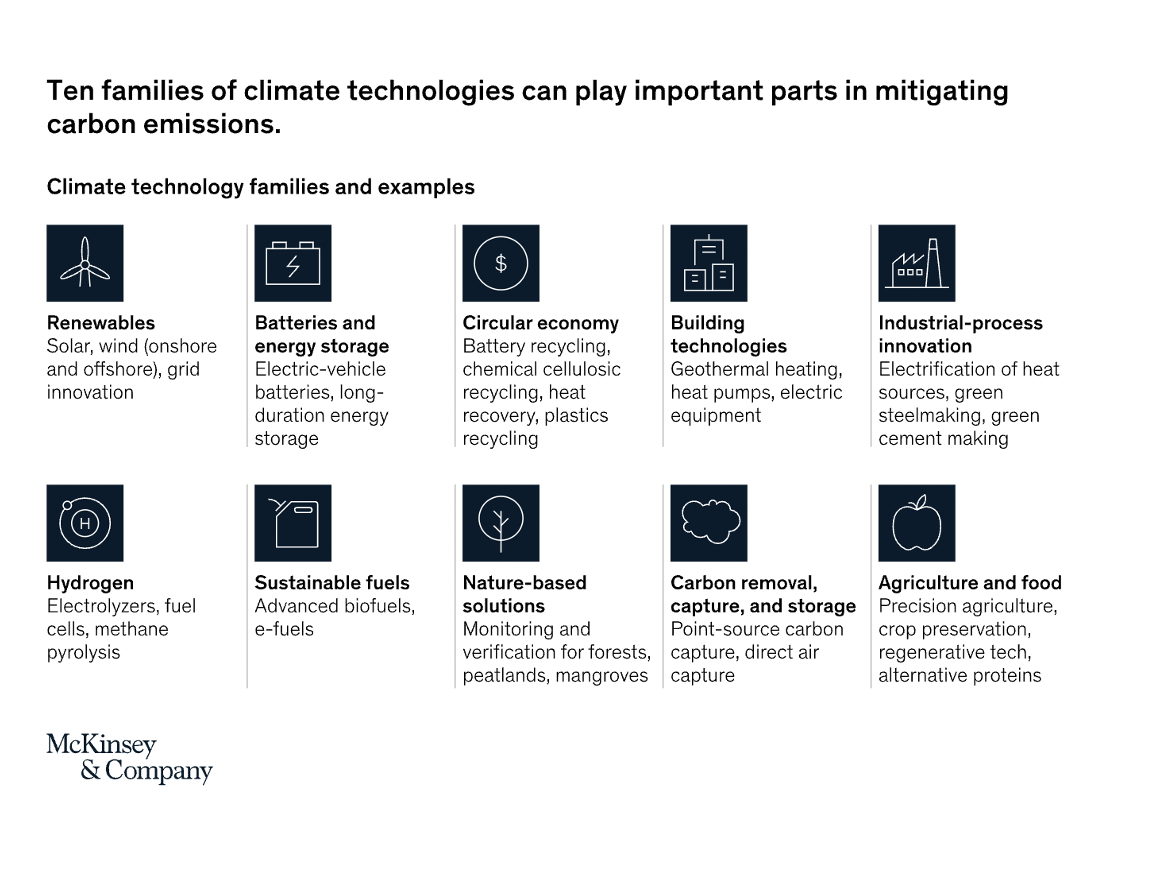
Oh dear. A couple of good Cop 28 headlines on the agreed funding of climate loss and damages for developing nations were followed by a howler from COP 28 President and host, Sultan Al Jaber. His poorly chosen words – to suggest there is “no science” indicating a need to phase out fossil fuels in meeting 1.5 degree global warming targets – was a leadership loss. However, global business is doing a much better job at leading a planet survival mission on decarbonisation. The umbrella term for this mission is sustainability and many businesses now ‘get it’. We recently attended a Cleantech Briefing for Senior Leaders at the Irish Management Institute in Dublin and were struck by a couple of key messages:
- Cleantech projects are a very visible recipient of billions of dollars of funding but the concept of sustainability requires a bigger picture mind-set and understanding of how a number of technologies will fit into a sustainable circular economy. See the graphic below of the 10 technology families (Source: McKinsey).
- The circular economy will fundamentally change business models for many sectors. Sustainable recycling of energy, waste and water means many businesses can no longer just sell goods and walk away. The ‘reverse logistics’ of the return of used goods will force a radical change in life-cycle costs on top of regulatory requirements for green materials in manufacturing and the building of proprietary clean energy sources.

- A large construction firm with a multi-year track record in building data centres(DCs) is currently working on a DC project where the green energy source will be built in parallel with the data centre.
- The built environment (construction and existing buildings) account for 40% of global CO2 emissions. In fact, the manufacture of steel and cement accounts for a whopping 15% of global emissions. The entire supply chain of construction is moving to more sustainable solutions from materials used, to transport, to energy, to water consumption.
So, even the construction of cleantech projects like battery gigafactories, bio-refineries or green steel manufacturing facilities need ‘joined-up thinking’ and sustainable practices. Bigger corporates are already implementing sustainable policies and practices in line with stakeholders’ (clients, investors, workers etc) requirements but, with increased burdens imposed by Scope 3 emissions reporting and Corporate Sustainability Directives (CSDR), there are huge implications for all sizes of companies in a supply chain. The large construction firm referenced above has more than 5,000 companies in its supply chain alone. All speakers at the briefing agreed that the following had huge roles to play in ensuring supply chain compliance in a circular economy:
- Education: Smaller firms don’t have big teams of experts. They need training and support.
- Government: Funding of sustainability focused projects are time sensitive and require more efficient government processes to access funding.
- Data management: Not for the first time, business transitions require good data management. The collection and timely access to sustainability data will be critical for all firms in their efforts to meet reporting requirements to clients, customers, government etc.
Finally, finance. Money makes the world go round they say. Not quite, but the panellists were all agreed that the financial and trading penalties for failing to fit into the circular economy and meet sustainability standards will be business killers. The Head of Sustainability at one of Ireland’s pillar banks described the increasing scrutiny of loan books by their stakeholders (particularly bond holders) and their own intiatives in launching loan products which would be aligned with sustainability targets. In other words, if a borrower meets sustainability benchmarks they will benefit from lower interest rates and better terms. If they don’t, they will suffer higher funding costs. For serial offenders, it is likely they will be unable to access capital or insurance in the near future.
So, the message is clear. We are all in this circular economy to drive a more sustainable future. And, if we don’t …… well the expression “what goes around, comes around” springs to mind. However, keep that annual spend of $6.5 trillion in mind and imagine the opportunities to play one’s part in the sustainability mission. Because, it’s worth it.
Post Details
Category
Industry News
Date
December 5, 2023
Author
SilverBack
Leave a Comment